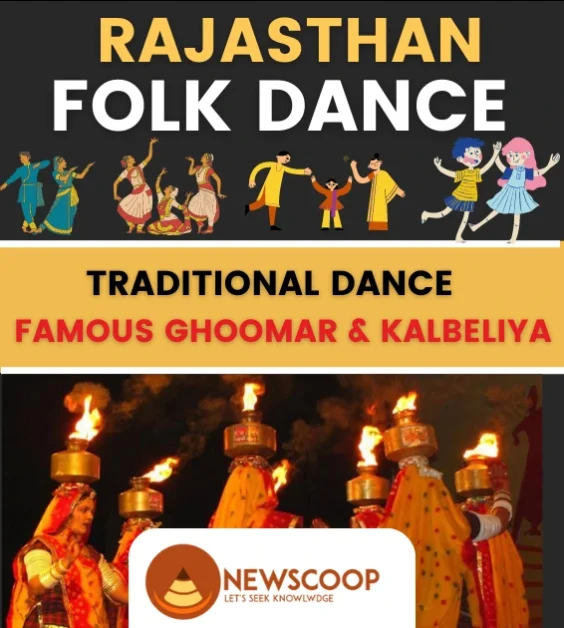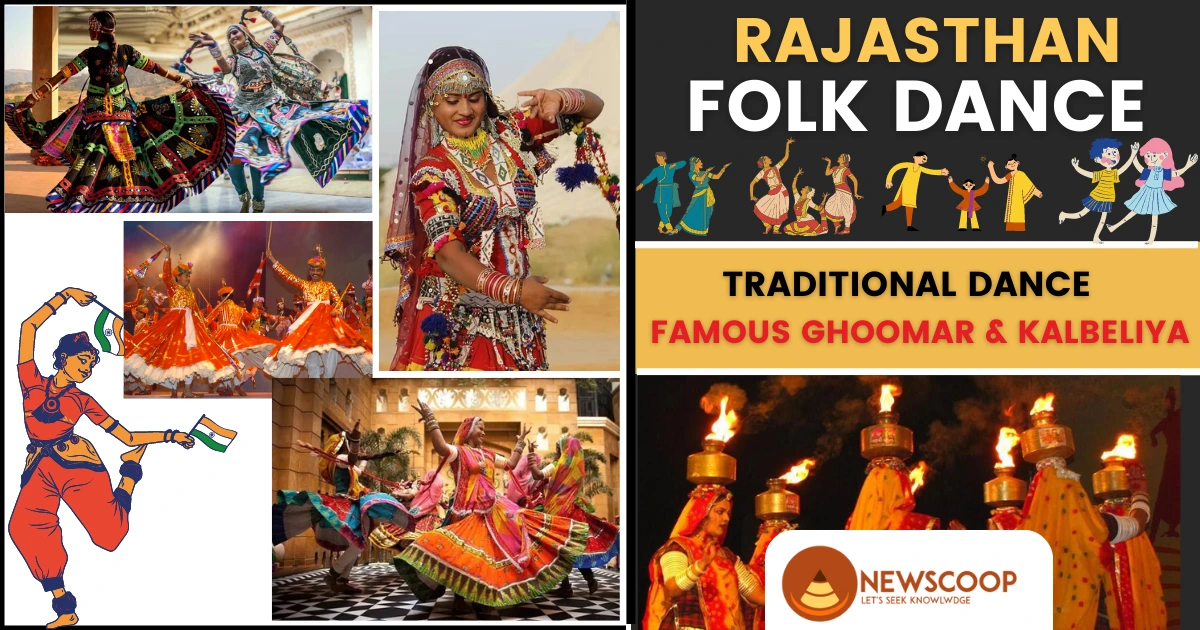Folk Dance of Rajasthan: List of Famous Traditional Dance Forms
Rajasthan is often called the “Land of Kings” and is famous for its lively culture, rich history, and captivating folk traditions. Among its many cultural treasures, the traditional folk dance of Rajasthan truly stands out as a remarkable testament to the state’s unique identity and heritage.
In this article, we’ll take you on a journey through the well-known folk dances of Rajasthan that continue to captivate people worldwide.
Introduction to Folk Dance of Rajasthan
Rajasthan’s folk dances have earned their fame through their embodiment of the region’s rich cultural heritage, unique identity, and captivating visual splendor. With each dance presenting a distinctive style and narrative, from the graceful spins of Ghoomar to the rhythmic footwork of Kalbelia, these performances become an integral part of cultural celebrations, preserving age-old traditions while telling stories through expressive movements.
Their ability to connect with audiences on a global scale, coupled with UNESCO recognition for dances like Kalbelia, has solidified their status as not only a source of entertainment but also a powerful representation of Rajasthan’s vibrant past and present.

Famous Folk Dances of Rajasthan
The following are some famous folk dances of Rajasthan:
- Ghoomar
- Kalbeliya
- Bhawai
- Kachhi Ghodi
- Gair
- Chari
- Chang
- Kathputli
- Chakri
- Terah Taal
1. Ghoomar
- Ghoomar is a popular folk dance of Rajasthan, historically performed for royalty’s entertainment.
- Originated with the Bhil tribe and was later embraced by Rajput communities and others.
- Women perform Ghoomar during festivals like Holi, Teej, and when a bride arrives at her new home.
- Dancers wear traditional attire, including a ghagra (long skirt), Kanchli or choli (blouse), and an odhani (veil).
- The dance involves graceful movements such as swaying hands, clapping, and twirling, accompanied by traditional songs and instruments.
- Coordinated movements, twirling attire, lively rhythm, and music create a mesmerizing display.
- Ghoomar is highly favored in Udaipur, Kota, Bundi, and Jodhpur, and often involves audience participation.
2. Kalbeliya
- Kalbelia, a folk dance of Rajasthan, is known as the “Sapera Dance” or “Snake Charmer Dance” due to its serpentine movements.
- The dance originates from the Kalbelia tribal community.
- Women dancers wear traditional attire: Angrakhi (jacket-like garment), odhani (veil), and swirling black ghagra (long skirt).
- The dance is characterized by sensual movements and formations that mimic snake-like motion.
- Men provide music using traditional instruments like dholak (two-headed drum), Khanjari (percussion instrument), and pungi (woodwind instrument).
- Other traditional instruments like Dufli, Morchang, and Khuralio are also used.
- Songs are inspired by folklore and mythology.
- The best places to witness Kalbelia dance include Jodhpur, Jaisalmer, Bikaner, Barmer, Jalore, Jaipur, and Pushkar.
3. Bhawai
- Bhawai dance involves female dancers balancing 7-9 brass pitchers on their heads while performing rapid dance steps.
- Dancers use the sole of their feet on glass or a sword’s edge for stability.
- Tribes in Rajasthan, such as Bhils, Meenas, Kumhars, Jat, Kalbelia, and Chamars, have been practicing this folk dance for ages.
- Dancers in Rajasthan, accustomed to carrying multiple pots daily for water, naturally developed the skill of balancing pots on their heads.
- Bhawai dance can be performed on ascending plates supported by tumblers, broken glass, or a sword.
- Dancers execute challenging balancing acts with precision, often on narrow, unstable surfaces.
- Men accompany the dance with traditional music, using instruments like Jhanjhar, Dholak, harmonium, sarangi, and pakhawaj.
- Dancers wear vibrant traditional Rajasthani attire, enhancing the grace and enchantment of the performance.
4. Kachhi Ghodi
- Kachhi Ghodi is a renowned folk dance performed by Rajasthani men, originating in Shekhawati region.
- The dance reenacts local bandit tales, featuring mock sword fights and lively choreography.
- Performers wear traditional attire, including dhotis, turbans, and kurtas, and ride decorated dummy horses.
- Symbolic of chivalry and bravery, the dance is a portrayal of traditional valor.
- The flute defines the dance’s soundtrack, adding to the overall ambiance.
- Primarily performed at weddings and social events, the dance is commonly seen in the Shekhawati region, Jaipur, and Udaipur.
5. Gair
- Gair dance is performed by members of the Bhil tribe from Rajasthan.
- The dance involves performers moving in a large circle, with some members leaving and rejoining the circle on alternating beats.
- Thumping beats, often produced by beating sticks, contribute to the rhythmic accompaniment.
- Dancers initially move clockwise and then shift to an anti-clockwise direction.
- “Gair” translates to “circle,” reflecting the circular formation of the dance.
- Dancers wear long pleated tunics resembling skirts, adorned with attractive jewelry, and carry swords, enhancing the visual appeal.
- Musical instruments like dhol, nagada, and dholak provide the background music.
- Gair dance is predominantly performed during Holi and Janmashtami (Lord Krishna’s birthday).
6. Chari
- Chari dance’s name translates to “pot,” symbolizing the significance of pots in the dance.
- The dance involves balancing pots, representing the strenuous efforts of Rajasthan’s desert women who walk miles for water.
- Brass pots are filled with cottonseed, creating a torch-like effect when ignited.
- In some variations, a lit lamp is placed on the pot, and dancers move their hands freely to traditional Rajasthani folk music played on traditional instruments.
- The Gujjar community of Kishangarh primarily performs the Chari dance.
- It honors the hard work of women fetching water and is also performed during childbirth or weddings.
- Dancers adorn themselves with ornaments like large nose rings, Gajra (flower garland), armlets, Hansli (necklace), and Mogri (headgear).
7. Chang
- Chang is an Enthusiastic folk dance originating from the Shekhawati region (Bikaner, Churu, Jhunjhunu, Sikar) in Rajasthan.
- Also known as Dhamal, characterized by fast-paced rhythmic beats of the chang instrument (a tambourine), guiding men’s dance and songs.
- Unique element: Some men dress as women, wearing traditional attire and performing the ghoomar dance, adding fascination to the performance.
- Celebratory Period: Performed from Maha Shivaratri to Dhulandi (day after Holi) to commemorate the triumph over evil.
- The prime location to experience this Rajasthani folk dance is the Shekhawati region.
8. Kathputli
- The name is derived from “Kath” (wood) and “putli” (doll with no life).
- Puppet dance originated with the Bhat tribal community of Rajasthan over a millennium ago.
- Kathputli puppets are crafted from mango wood, stuffed with cotton, and typically around 1.5 feet tall.
- Puppet-making centers include Sawai-Madhopur, Bari, and Udaipur.
- Puppeteers control the puppets via strings attached to limbs while also singing, imparting stories from Indian folklore and mythology.
- Some stories address contemporary social issues.
- Kathputli Colony in New Delhi is a historic settlement for puppeteers.
- Organizations like Bhartiya Lok Kala Mandal in Udaipur and Rupayan Sansthan in Jodhpur contribute to preserving and promoting Kathputli art.
- The Marwar region is a prime destination to experience this captivating folk dance of Rajasthan.
9. Chakri
- Introduced by the Kanjar tribe in Rajasthan’s Kota and Baran regions.
- Women of these areas, particularly Kota and Baran, practice Chakri dance and perform it on various occasions.
- “Chakri” means wheels, resembling the dance’s appearance where women in traditional Rajasthani skirts adorned with mirror work whirl rapidly, resembling spinning wheels.
- Performed in groups, dancers circle around and maintain a continuous circular movement.
- Music is integral: Starts slow, gains momentum, and encourages audience participation.
- Skilled performers: Women need focus and skill to avoid collisions while spinning rapidly to prevent accidents.
10. Terah Taal
- Terah Taal is an ancient folk dance of Rajasthan performed by Kamada tribe women.
- Performed before the image of Baba Ramdeo, the dance involves sitting on the floor.
- The dance begins with 13 Manjeeras (brass discs) attached to the dancer’s body, creating rhythmic sounds during movement.
- Dancers may also use a sword and a pot to enhance their performance.
- Male artists accompany instruments like pakhwaja, dholak, jhanjhar, sarangi, and harmonium, singing local Rajasthani folk songs.
- A prominent folk dance of Rajasthan performed during various popular festivals.
- Noteworthy places to witness Terah Taal include Ramdevra, Dindwana, Dungarpur, and Udaipur.
Importance of Folk Dance in Rajasthan

The folk dance of Rajasthan are cultural keystones, embodying heritage and communal unity. Beyond entertainment, they safeguard traditions through generations, bridging past and present. These dances, performed during festivals and celebrations, celebrate diversity, preserving distinct identities.
Their economic role through tourism bolsters communities. Educational and social platforms, they raise awareness on historical narratives and contemporary issues. As artistic expressions, they showcase skill and devotion, preserving craftsmanship. Folk dances animate Rajasthan’s cultural canvas, weaving narratives, promoting togetherness, and reflecting the state’s vibrant soul.
Also Read: Folk Dance of Madhya Pradesh
Conclusion
In essence, Rajasthan’s folk dances embody the heart and soul of a rich and diverse cultural heritage. Through graceful spins, rhythmic footwork, and mesmerizing movements, these dances narrate stories of valor, love, and everyday life.
They connect communities, celebrate traditions, and continue to captivate audiences, making Rajasthan’s cultural tapestry come alive through the art of dance.
Thank You!

